
St. Thomas Becket
Archbishop and martyr
Archbishop and martyr
1118-70 | Feast: Dec. 29
1118-70 | Feast: Dec. 29
Going against a nation’s highest political power rarely ends well, but God calls us to defend the truth, no matter the opposition – or the consequences. Thomas Becket took this to heart as the King of England demanded allegiance to the crown before God.
As chancellor to King Henry II in medieval England in 1155, Thomas oversaw the collection of the king’s revenue. With great responsibility came great trust from the king, who believed it would be advantageous to make Thomas the archbishop of Canterbury. Though Thomas warned King Henry that he might not accept interference in Church affairs, he was still confirmed archbishop and, against the king’s wishes, resigned as chancellor in 1162.
Tensions between the king and Thomas were high from then on as the king pushed the boundaries of Church and state. King Henry wanted clergy accused of serious crimes tried in his courts rather than ecclesiastical courts. Conflict came to a head in 1164 when Thomas first agreed but later refused to seal the Constitutions of Clarendon, a document that asserted the king’s dominion over clergy and denied them the right of trial by Church, leading to criminal charges and a six-year exile. During this time, Henry had his son crowned as archbishop of York, without the archbishop of Canterbury, whose prerogative it was to coronate the archbishop of York. Becket excommunicated the three bishops who consecrated Henry’s son. Thomas was allowed to return to England in 1170, but King Henry was furious about the bishops who were excommunicated. Four knights interpreted the king’s grumbling as a royal command to “rid him of this troublesome priest.” Soon thereafter, these knights invaded the cathedral and murdered Thomas during vespers.
Thomas Becket was canonized just two years after his death. Canterbury Cathedral, the very place where he was murdered, became home to his shrine until 1538 when the Reformation swept through England and King Henry VIII attempted to suppress devotion to this brave saint by destroying the shrine. Thomas’ bloody tunic was returned to the Canterbury Cathedral in 2020, on the 850th anniversary of his murder, by Pope Francis.



